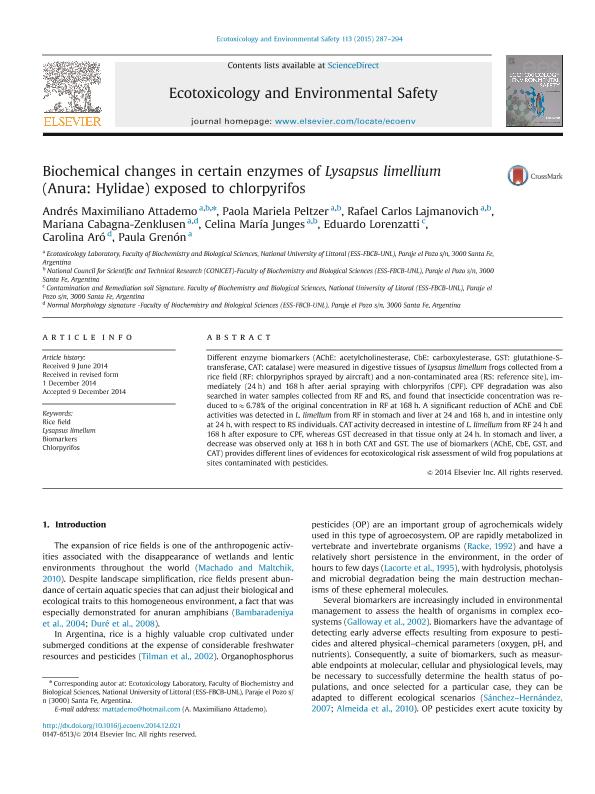Artículo
Biochemical changes in certain enzymes of Lysapsus limellium (Anura: Hylidae) exposed to chlorpyrifos
Attademo, Andres Maximiliano ; Peltzer, Paola
; Peltzer, Paola ; Lajmanovich, Rafael Carlos
; Lajmanovich, Rafael Carlos ; Cabagna Zenklusen, Mariana Cristina; Junges, Celina Maria
; Cabagna Zenklusen, Mariana Cristina; Junges, Celina Maria ; Lorenzatti, Eduardo Antonio
; Lorenzatti, Eduardo Antonio ; Aró, Carolina; Grenón, Paula
; Aró, Carolina; Grenón, Paula
 ; Peltzer, Paola
; Peltzer, Paola ; Lajmanovich, Rafael Carlos
; Lajmanovich, Rafael Carlos ; Cabagna Zenklusen, Mariana Cristina; Junges, Celina Maria
; Cabagna Zenklusen, Mariana Cristina; Junges, Celina Maria ; Lorenzatti, Eduardo Antonio
; Lorenzatti, Eduardo Antonio ; Aró, Carolina; Grenón, Paula
; Aró, Carolina; Grenón, Paula
Fecha de publicación:
01/2015
Editorial:
Elsevier
Revista:
Ecotoxicology and Environmental Safety
ISSN:
0147-6513
Idioma:
Inglés
Tipo de recurso:
Artículo publicado
Clasificación temática:
Resumen
Different enzyme biomarkers (AChE: acetylcholinesterase, CbE: carboxylesterase, GST: glutathione-Stransferase, CAT: catalase) were measured in digestive tissues of Lysapsus limellum frogs collected from a rice field (RF: chlorpyriphos sprayed by aircraft) and a non-contaminated area (RS: reference site), immediately (24 h) and 168 h after aerial spraying with chlorpyrifos (CPF). CPF degradation was also searched in water samples collected from RF and RS, and found that insecticide concentration was reduced toE6.78% of the original concentration in RF at 168 h. A significant reduction of AChE and CbE activities was detected in L. limellum from RF in stomach and liver at 24 and 168 h, and in intestine only at 24 h, with respect to RS individuals. CAT activity decreased in intestine of L. limellum from RF 24 h and 168 h after exposure to CPF, whereas GST decreased in that tissue only at 24 h. In stomach and liver, a decrease was observed only at 168 h in both CAT and GST. The use of biomarkers (AChE, CbE, GST, and CAT) provides different lines of evidences for ecotoxicological risk assessment of wild frog populations at sites contaminated with pesticides.
Palabras clave:
Lysapsus Limellum
,
Biomarkers
,
Chlorpyrifos
,
Rice Field
Archivos asociados
Licencia
Identificadores
Colecciones
Articulos(CCT - SANTA FE)
Articulos de CTRO.CIENTIFICO TECNOL.CONICET - SANTA FE
Articulos de CTRO.CIENTIFICO TECNOL.CONICET - SANTA FE
Citación
Attademo, Andres Maximiliano; Peltzer, Paola; Lajmanovich, Rafael Carlos; Cabagna Zenklusen, Mariana Cristina; Junges, Celina Maria; et al.; Biochemical changes in certain enzymes of Lysapsus limellium (Anura: Hylidae) exposed to chlorpyrifos; Elsevier; Ecotoxicology and Environmental Safety; 113; 1-2015; 287-294
Compartir
Altmétricas



